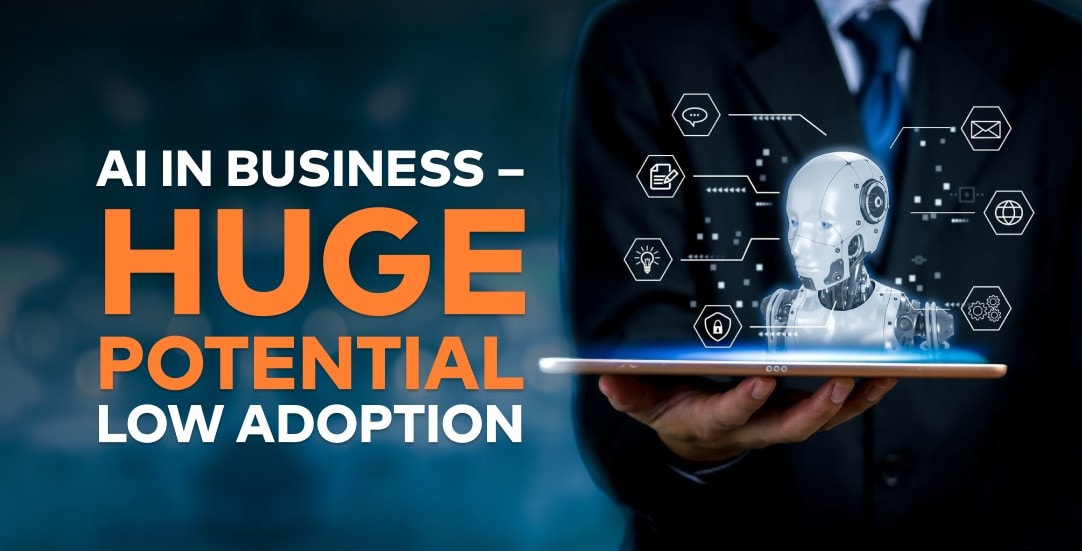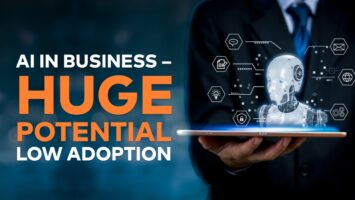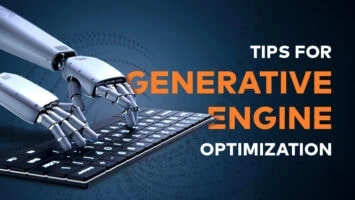AI in Business – Huge potential. Low adoption

Artificial intelligence is undoubtedly becoming one of the key drivers of economic growth. However, its real use in process optimization and automation remains limited. Many industries operate on a massive scale: creating platforms, apps, products, content, organizing events, or planning marketing campaigns at a pace that demands maximum efficiency. That’s why integrating AI as a practical support tool in business is a natural step, improving quality and speed without a complete process overhaul, and most importantly, meeting growing customer expectations.
Why do companies still struggle with the first step?
The biggest challenge is identifying the areas where AI can actually deliver measurable benefits. A lack of knowledge about its capabilities, its impact on the organization, and fear of change often lead companies to approach the topic superficially.
Of course, implementing AI, like any other change, faces classic barriers: limited budgets, operational priorities, and concerns about implementation costs. However, in practice, the main obstacles often turn out to be organizational and communication issues. Especially the so-called human factor.
In large organizations, introducing innovation requires not only investment but also trust, education, and proper process management. Another common challenge is employee concerns about job loss. This is understandable, which is why transparent communication and showing that AI is a tool to support people, not replace them, is crucial.
A good starting point is to talk with teams about their daily repetitive tasks. Implementing AI in simple areas that actually reduce workload demonstrates tangible benefits and builds trust. When employees see that these changes allow them to focus on strategic work, they are more open to further automation.
Where to start with AI implementation?
If the organization doesn’t have dedicated AI specialists, it’s worth leveraging the experience of external experts. This not only speeds up implementation but also helps avoid mistakes caused by sticking to outdated processes. Often, ready-made solutions are already available on the market and only need to be integrated with the existing infrastructure.
The implementation process typically involves several stages:
- Needs and goals analysis
First, you need to identify where the barriers are, whether it’s too much data, lack of fast analytics, limited resources for content creation, slow error detection in processes, or lack of offer personalization.
- Profitability analysis (ROI)
Every automation project should deliver a return on investment. It’s essential to assess whether the implementation will improve efficiency, reduce operating costs, or increase revenue.
- Choosing a solution
There are two paths here. If during the needs analysis you discover that there is already an existing solution in the market, then selecting an AI model is not necessary – you only need a qualified person to handle integration into your company ecosystem. If you decide on a custom solution, you need to collect data, choose a model, define the tech stack, and consider cloud-based solutions. Additionally, you must build a team or work with an external company that can implement the solution in compliance with market regulations.
- Data collection and model training preparation
If you decide to move forward with implementation, the next crucial step is collecting the right data. This may include customers history, revenues, clients behavior patterns, and any components required for generating indexable content. This stage is particularly complex due to the sensitive nature of the data, the need for thorough cleaning, and the requirement to anonymize it. When the implementation directly involves clients, it becomes essential to establish a centralized repository of clients attributes to train the models effectively. Once you opt for a custom solution and assemble a dedicated team, the subsequent phases involve developing and training the models, integrating them with production systems, ensuring robust data security, and maintaining continuous performance monitoring.
What benefits does AI bring to business?
AI not only speeds up processes, it allows them to scale without losing quality. We’re moving from an experimental phase to a stage where AI becomes the foundation of modern products and services. Companies that adopt AI today gain a competitive edge – delaying implementation means having to catch up later.
AI applications in business are extensive:
- Operational process automation (e.g., testing, reporting, quality control),
- Offer and communication personalization (e.g., product recommendations, campaign targeting),
- Data-based analysis and prediction (e.g., demand forecasting, supply chain optimization),
- Supporting strategic decisions (e.g., anomaly detection, risk analysis),
- Customer service (e.g., chatbots, automated responses, recommendation systems).
Common mistakes and myths about AI in business
One of the most common mistakes is assuming that AI will solve all problems “by itself.” In reality, AI is just a tool, it requires strategy, quality data, and a competent team. Another mistake is skipping ROI analysis, implementing AI simply because “others are doing it” often leads to costly failures.
There are also two dangerous myths:
- AI will completely replace humans,
- AI implementation means job cuts.
The truth is different. AI is meant to support people by handling repetitive tasks and enabling them to focus on creative and strategic work. Companies that treat AI as a partner, not a “cheaper workforce”, achieve better results and more sustainable growth.
AI is changing how we think about business
The biggest transformation AI brings is a mindset shift, once organizations see how technology accelerates and simplifies processes, it’s hard to go back to old methods. We’re entering an era where more and more products and services are designed with AI at the core.
However, despite its enormous potential, AI cannot replace what truly matters—human creativity, contextual understanding, and the ability to create valuable customer experiences. Technology can help deliver better solutions, but people remain the most important element of the business ecosystem.




















